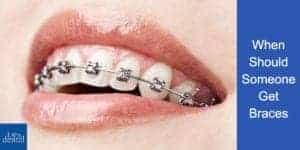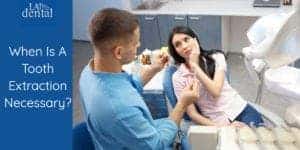Braces are one of the oldest and most common forms of tooth alignment, and they have been around for decades. Traditional metal braces are effective and provide lasting orthodontic results for patients. If you are considering braces, this post is a good place to start. Read on for everything you need to know about traditional braces.
What Are Traditional Braces?
When you think of braces, it’s likely you think of metal wires and brackets, fused to the front of your teeth. Traditional braces are exactly that, they are the classic metal braces. Traditional braces work by slowly aligning teeth into place with periodic tightening and consistent pressure. Braces usually take 6 months – 2 years, treatment time varies because every orthodontic case is different.
What Is A Good Age To Get Braces?
The ideal time for treatment is between 10 and 14 years old. It’s best to manage misaligned teeth as soon as a child’s adult teeth have grown in. When we catch and treat problems early, we are able to prevent future orthodontic complications. Therefore, pre-teens and teens are the best candidates for braces.
According to a recent study of orthodontic patients, the success rate of braces is around 100% in 12-16-year-olds and around 70% for adults aged 20-47 years. All the people in the control group for this study had similar issues of severely impacted teeth.
In this study, the adults needed more visits to achieve the same results that the younger group achieved in a shorter period of time. However, if you are an adult and you have moderate to minor orthodontic needs, braces may be able to achieve 100% of your correction goals.
There are many adults with crooked teeth who did not get the orthodontic treatment they needed in childhood. Teeth can also shift over time and those with perfect teeth as kids can end up with crooked teeth in adulthood. In adults ages,
Average Cost Of Getting Traditional Braces In Los Angeles
The average cost of getting braces in Los Angeles is between $3,000 and $20,000. This cost depends on what kind of braces you select, the length of treatment, and the complexity of your orthodontic needs.
Metal braces are the oldest type of braces. They are also among the most affordable, starting at $3,000, but can cost more depending on the situation. Tooth-colored ceramic braces or lingual braces cost more. The cost can vary greatly from case-to-case.
Here’s what we recommend when it comes to cost and payments –
- Consult a dentist to get a quote
- Check with your insurance if the cost of the recommended orthodontic treatments are covered by your plan
- Ask your dental office if they offer any financing options to make it easier to pay for the treatment
At LA Dental Clinic, we accept all PPO insurance plans. We also provide financing options to pay smaller installments over time.
Success Rate Of Traditional Braces
Overall, patients with traditional braces have a high chance of seeing excellent results. The success rate is also higher and faster among younger patients as compared to adults whose teeth are already firmly in place.
There is little value in trying to correct a child’s first set of teeth which will fall out. However, your dentist can prepare your child for braces by preventing overcrowding and applying expanders as needed.
The success rate of braces is high, this is a tried and true method of orthodontic tooth alignment. However, nothing is perfect and this applies to braces as well. Braces are made up of metal wires and brackets. The brackets are fused to the front of your teeth, often with dental bonding material. The wires link the brackets and together, with tightening, the wires and brackets slowly move the teeth into alignment. There are instances in which brackets can fail.
This rate varies depending on how well the patient cares for their braces and where the bracket is located. For example: brackets on molars have a higher failure rate than canine or central teeth, but the general failure rate is as low as 10%. As adhesives continue to improve, this rate is projected to decrease. Bracket failure simply means that the bracket becomes detached from the tooth and has to be fused back. It does not dramatically affect the end results of your treatment unless it is not repaired. You can avoid bracket failure by following your dentists’ instructions carefully, cleaning thoroughly around your braces and avoiding foods that could get caught in your braces.
Average Length Of Treatment
The average length of treatment for braces is 2 years, but the general range is 18 to 30 months. This is then followed by a year or two of wearing a retainer. However, the exact time and number of appointments you will need will depend on your specific treatment plan.
If you have simple needs, such as a few crooked teeth, then your treatment will be shorter compared to a person who needs to correct a crossbite or fix an issue with tooth spacing. This is because bite issues often require extra help from additional orthodontic fixtures and devices like headgear.
Patients with complicated needs may need extra preparation to make their teeth ready for braces, such as tooth extraction, expanders, root canals, or gum care. These steps play a large role in the success of your treatment and should be completed before braces are installed.
Age also is a factor. Older patients generally take more time to correct issues and require more in-office visits. Their jaws and teeth are firmly set as opposed to adolescents who are still growing.
Contact Us
If you are thinking about getting braces, it’s a good idea to come in for a consultation. Traditional braces are an incredibly effective way to align your teeth, they have stood the test of time. Learn more about this procedure, as well as the types of braces we offer by visiting our braces information page. Contact us or call 213-385-9710 to schedule an appointment and learn more about whether or not braces are the right option for you.



